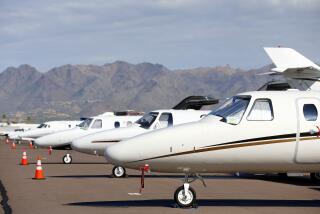Withholding Tax on Fringe Benefits Scheduled by IRS
WASHINGTON — The Internal Revenue Service proposed Wednesday that employers begin withholding money next summer from the paychecks of employees who receive such fringe benefits as the use of company cars and company aircraft.
Such benefits long have been taxable, but the government has been dependent on taxpayers’ willingness to voluntarily report this income. The proposed rules are the first specific guidelines for collecting those taxes.
“Fringe benefits have been around a long time, and they are a very difficult and sometimes very controversial part of the tax law,” IRS Commissioner Roscoe L. Egger Jr. told a news conference. “We are trying to set down some reasonable, specific rules people can follow. We have tried to be as generous as we can be.”
The proposed regulations were drafted in response to the passage of the 1984 tax law, in which Congress directed the IRS to prepare detailed rules on fringe benefits. Unless Congress now acts to block the rules, tax withholding on the value of the fringe benefits will begin in July.
Under the proposal, a company would calculate the benefits’ value at the end of each quarter and then would withhold 20% of that value from the paychecks of affected employees. Government officials said that they did not know how many of the nation’s 95 million taxpayers would be covered by the rules.
Certain fringe benefits provided by companies are specifically excluded from taxation, including the value of health insurance costs and premiums, the value of premiums on up to $50,000 in life insurance, employee discounts and company cafeterias and athletic facilities open to all employees.
But the IRS announced also Wednesday that it is considering tighter rules making management employees who dine in executive cafeterias and exercise in executive gyms pay taxes on those benefits. However, no decisions have been made yet.
Under the proposed regulations, the IRS would link taxes for employees who have full-time use of a company car to the cost of leasing the same vehicle and the proportion of miles the car is driven for personal use.
For example, the IRS calculates that a car that costs $10,000 could be leased for $2,850 a year. If 25% of the mileage in a year involves personal use, the taxable income would be $712.50, or 25% of the annual cost of leasing the car.
In some firms with large fleets of vehicles, more than one worker may drive the same car on company business during a single day, with one person taking the vehicle home overnight. In those cases, where the only personal use is for commuting, the worker who keeps the vehicle at his or her home would incur an additional $4 a day in taxable income--the IRS estimate of commuting costs. The “commuting rule” is expected to cover such vehicles as police cars, ambulances or delivery vans that frequently are garaged at an employee’s home.
For aircraft, the IRS proposes the following rules:
--If a company plane is making a regular business flight and an employee “hitchhikes” on the flight for personal reasons, the taxable income is the value of coach fare on a commercial flight.
--If a key officer or owner of the business arranges a special flight for personal purposes, such as traveling to the Super Bowl or going hunting, that person’s extra taxable income will be the cost of chartering an aircraft to make the same flight.
More to Read
Inside the business of entertainment
The Wide Shot brings you news, analysis and insights on everything from streaming wars to production — and what it all means for the future.
You may occasionally receive promotional content from the Los Angeles Times.









